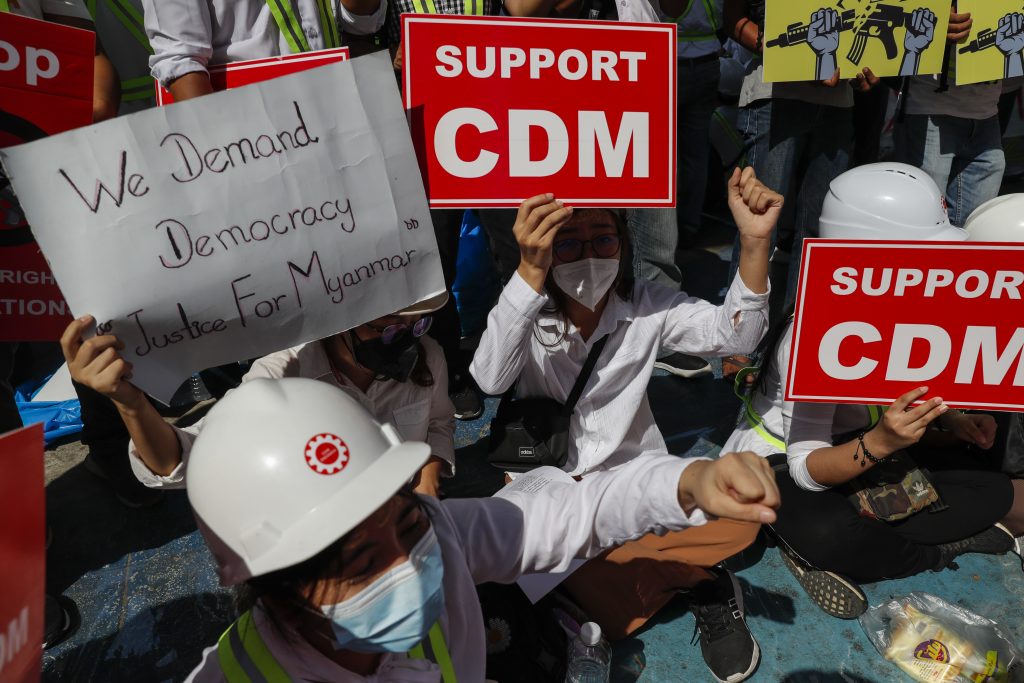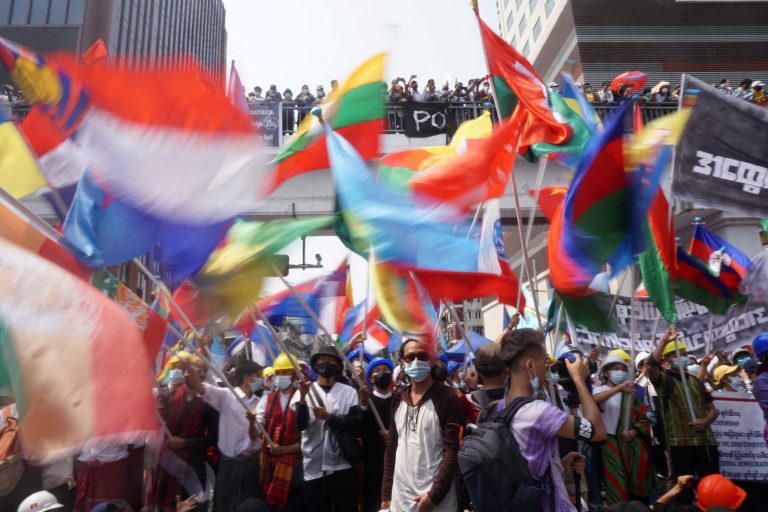OPINION
Myanmar’s Civil Disobedience Movement has involved tremendous sacrifice, but if this is not to be in vain, the movement needs to be reborn as an independent, nonviolent force focused on creating change rather than promoting divisive political identities.
By YE HTET
Early on, the Civil Disobedience Movement defined resistance to the February 2021 military coup. Although the term has been applied in a variety of ways, the CDM is widely conceived as a general strike, with civil servants refusing to go to work in order to undermine the military regime. It peaked in February and March 2021, with estimates of between 400,000 and 1 million government staff shunning their workplaces.
Myanmar has previously seen general strikes, during the colonial era in 1938 and in another anti-military uprising in 1988, but today’s CDM is unprecedented in its scale and duration. Yet, despite the massive sacrifice and commitment involved, huge question marks hover over the success and sustainability of the movement.
Its organisers acknowledge that the movement has not reached its primary goal of pushing a crippled junta to cede power. The two main reasons for this, many of them say, are brutal repression from the regime and the refusal of selfish, irresponsible government workers to participate in the strike. There is some truth to these arguments, but they concern factors that members of the movement cannot directly control. Fixating on them will therefore not help in developing a better strategy.
What needs to change?
Given the need for mass participation – from government workers but also the wider public that must support them while they are on strike – an effective strategy also needs to be a fair one. The CDM was originally perceived as short-term pain for long-term societal gain, but two and a half years on from the coup, the pain is becoming chronic – and its unequal distribution across society has grown all too apparent.
The largest groups to go on strike have been teachers and healthcare workers, who provide essential services to low-income families and rural communities. Although members of the resistance have tried to set up parallel services, repression by the junta means they are unable to substitute for state providers across the country. Therefore, while many of the skilled professionals leading the CDM can afford private services, the poor are stuck with understaffed schools and hospitals, with sometimes deadly consequences.
Mass participation also requires a positive message of unity and inclusion, but the CDM has in practice fuelled social division. A case in point is the draft CDM policy released in January by the National Unity Consultative Council, a resistance coordination body. The draft policy proposes that civil servants that joined the CDM be rewarded after the revolution succeeds, while those who stayed in their government jobs would face a range of punishments including dismissal, blacklisting and even travel bans, depending on their rank. Controversially, it says workers who joined the strike after April 2021, or had since returned to work, would be disqualified as CDM participants.
This division of people between heroes and traitors to the revolution is at odds with the messy reality, where people need to make hard choices to stay safe and support their families. Those who have opted not to leave their jobs for a variety of reasons have also been subjected to verbal abuse, doxing and other forms of online harassment, as well as routine violence and assassination. While this may have succeeded in coercing some people to join the strike, it has been at the cost of greater animosity and distrust. For some families in difficult situations, it may also have alienated them from the anti-junta struggle and pushed them towards the regime for protection.
Another aspect of the CDM that needs to be debated is its relationship with political authority and armed resistance. The movement was conceived at the outset as a nonviolent civic movement run by ordinary members of society. However, participants have largely ceded leadership to the National Unity Government and Committee Representing Pyidaungsu Hluttaw, because they are considered Myanmar’s legitimate government and legislature respectively. The two institutions have reaffirmed this leading role by providing IDs to CDM participants, setting the April 2021 deadline for joining the strike and promising compensation for lost salaries and benefits. Although they have largely failed to deliver on these promises, they have employed some striking civil servants as staff.
After the armed resistance gained momentum and the NUG declared a “defensive war” in September 2021, the CDM’s explicit links to the parallel government put its members in substantially more danger. The junta, which was already jailing CDM organisers, then jumped at the opportunity to crack down on the movement more harshly, by blurring the lines between nonviolent and armed struggle. The risks of joining the movement rose, and organisers therefore found it harder to recruit new members without coercing them.
How, then, can the CDM be put on the path to success? I have three proposals.
1. Moving from identity to action
The word “movement” in the name CDM implies its focus should be on creating change, not asserting identities. Throughout the past two and half years, however, most of the discourse has focused on categorising people as being either “CDM” or “non-CDM” and praising the former while denigrating the latter. As discussed, this hard binary creates rancour and division, but it also misdirects the energies of people in the movement. Those who leave their government jobs are led to believe that their work in the movement is largely done, when in reality there are so many more ways for individuals to contribute.
This is why an action, rather than identity, centred approach is needed. This should be one that sees beyond labels and asks what everyone in society, regardless of what position they occupy, can do in their daily lives to help overturn structural oppression and long-standing injustice. Civil disobedience icon Mahatma Gandhi once said, “Hate the sin, not the sinner”, and this should be the essence of a civic movement. Current debates over who is or is not CDM should be replaced with the questions “what do we want” and “how can we get it, individually and collectively”?
2. Thinking from the bottom up
Currently, though, the question “how can we get it?” is answered in a way that further disempowers individuals. The popular idea is that the CDM together with other resistance fronts will beat the military once and for all, and only then will Myanmar’s education, governance and other systems as well as its cultural practices be changed. While resistance groups have set up their own systems in some places, these are explicitly “interim” in nature; and given their vulnerability to attack from the junta, they require regime change to be institutionalised. This zero-sum notion of change can make the contributions of ordinary individuals feel inconsequential, meaning the movement is harder to sustain.
That’s why the CDM needs to adopt bottom-up thinking. Rather than seeing military dictatorship as monolithic, the movement should dissect the various social and institutional practices that uphold it. These pillars in turn depend on the participation of ordinary people, and so can also be toppled by them, one by one.
Therefore, instead of trying to abolish the entire public education system all at once, people can target the numerous ways that it contributes to authoritarian governance and culture. These include the teaching of Bamar-centric history, parrot learning and the inculcation of fear and obedience towards authority. Subverting these practices, for instance by promoting critical thinking both inside and outside the classroom, could create a more subtle and enduring form of revolutionary change. The same approach can be applied to other sectors, too.
3. Separating civil disobedience from armed resistance
Throughout history, civic movements have tended to distance themselves from armed resistance. While the latter requires only a limited number of men bearing guns, the former’s power comes from mass participation. To ensure participation from across society, civic movements tend to organise and act as visible, above-ground organisations. Historic examples include Myanmar’s own Dobama Asiayone during the anti-colonial struggle and the Indian National Congress led by Gandhi. Such organisations are often persecuted or even blacklisted by the authorities, but this is rarely permanent, and these groups tend to re-emerge with even stronger support.
Creating a clear separation between the CDM and Myanmar’s armed struggle will not be easy, particularly given the leadership that the NUG has sought over both of them. However, if managed carefully with a coherent plan, it will confer multiple advantages. Firstly, the junta would have less licence to brutally suppress the movement, particularly given its eagerness to distinguish peaceful opposition from what it labels “terrorism”. Such a distinction is of course made in bad faith, but it is integral to its empty mantra of “multi-party democracy” and can therefore be exploited by the movement.
Secondly, redefining the CDM as a purely nonviolent movement could allow it to eventually operate above ground when the political landscape shifts. The key is not to wait, but to prepare for that shift. In history, many of the most notorious dictators have at some point had to switch from confrontation to compromise – not because they wanted to, but because they had to. Imagine, at that time, hundreds of thousands of teachers, doctors, civil servants, students and people from all walks of life organising in the open while communicating directly with the wider public. This would be an enormous force with the power to re-shape Myanmar’s politics and society from the bottom upwards.
Sunk costs
The recommendations offered here are intended for debate; formulating solutions will require a much deeper examination of the constraints and opportunities presented by the Myanmar context. The CDM’s greatest obstacle to success is the sunk cost fallacy – the idea that because so much has been sacrificed, there is no going back from the current strategy, even if it is failing to deliver results or even causing harm. Overcoming this mentality will not be easy given the pain endured by people who have lost their careers, homes, families and friends in pursuit of a noble cause. But ultimately, this is all the more reason to openly debate and rethink strategy. Otherwise, the sacrifices really will have been in vain.
Ye Htet is a scholar and a trainer in nonviolent resistance.







